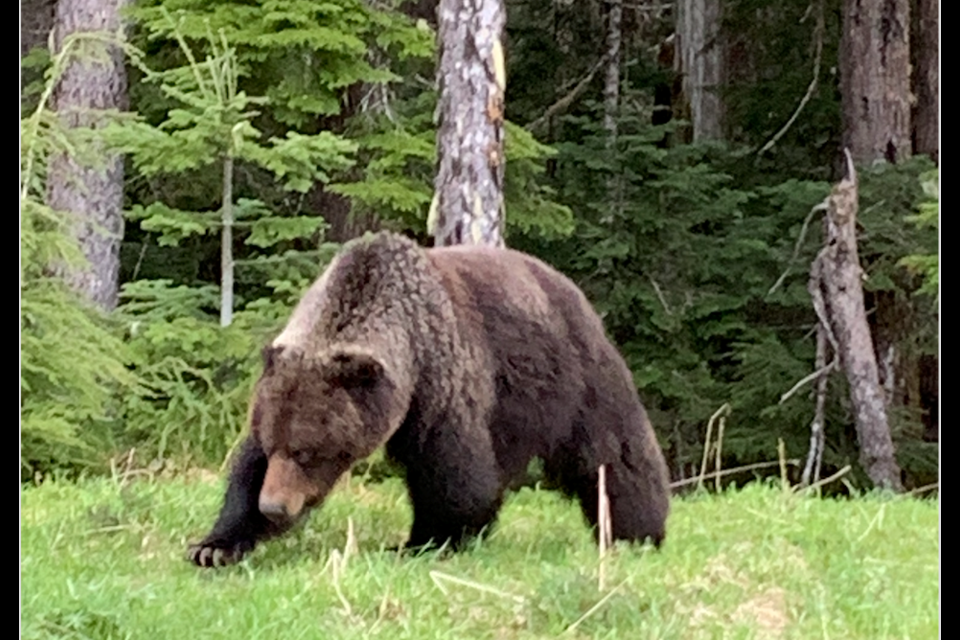The BC Conservation Officer Service (COS) is urging the public to avoid heading into the Callaghan Valley area after confirming several reports of a grizzly bear spotted feeding on natural vegetation beside Callaghan Valley Road, near Whistler Olympic Park.
Officers are “asking the public to avoid the area in order to allow the bear to feed in its natural habitat. Vehicles stopping within 100 meters to the bear can cause habituated behaviour and possible conflict,” the COS said in an emailed statement.
“The best thing we can all do for the bears at this time is to avoid areas where bears are feeding.”
Though the number of grizzly sightings in alpine terrain on the west side of Whistler Valley have increased in recent years, at times triggering a series of alpine trail network closures, the bears tend to be spotted in the valley bottom less frequently. The Coast to Cascades Grizzly Bear Initiative estimated in its 2021 update that there are approximately 59 bears in the Squamish-Lillooet population, which encapsulates the towns of Lillooet, Pemberton, Whistler and Squamish.
Whistler also saw a total of more than 70 millimetres of precipitation fall over the valley throughout the month of May, according to Environment Canada, while the average mean daily temperature was a mere 8 degrees C. That makes it the wettest and coldest May in Whistler since Environment Canada began recording those statistics in 2005.
That’s meant more snow for local peaks, and a lack of food availability in higher-elevation terrain for the area’s more commonly seen black bears, said Sea to Sky conservation officer Brittany Mueller.
“We've had a very busy spring, lots of active bears, and more than likely that's due to the late spring and a snow load that we have up top,” she said. “The only food availability for bears right now is in the valley bottom. The grass, all the natural vegetation, has them coming down and so we're seeing a higher frequency of bears in the valley than usual.”
It’s also meant more encounters, she said. but encouragingly, few of those encounters have been worrisome outside of a small number of reports of bears behaving aggressively. Mueller said that behaviour has mostly manifested in the form of bluff charging, including in one case where a series of reported bluff charges prompted the Resort Municipality of Whistler to temporarily close a section of the Valley Trail.
The black bear “was just starting to show some defensive behaviours, so we thought, ‘Let's close it down,’ with … the RMOW making that final decision. We were able to reopen it, I think after about a week, and that bear moved on.”
Whistler conservation officers received about 45 bear-related last month, according to Mueller, significantly more than the 24 reports officers received during May 2018, for example. No bears have been destroyed due to conflict with humans or relocated (aside from two cubs who were taken to Critter Care after their mother, found emaciated in Whistler’s Rainbow neighbourhood, was euthanized for humane reasons in April).
“For the amount of bear activity that we've had, we've had some reports of attractants being accessed, but overall people have been quite good at securing their attractants; making sure their bird food or bird feeders are put away, and we haven't had any major property damage or bears breaking into vehicles,” said Mueller.
“We're just again reminding the public to ensure that all attractants”—like garbage, barbecues and pet food—“are secured, dogs are on leash. If you see a bear, give it space, stay back at least 100 meters if you can, don't approach a bear and contact the RAPP line (at 1-877-952-7277) if they want to report any sightings or concerning behaviour.”
Mueller also encouraged locals to consider carrying bear spray when heading out on walks, runs or bike rides throughout the valley. “You just never know and it's a good tool in case of an emergency,” she said.
It remains illegal under B.C.’s Wildlife Act to harass wildlife or feed dangerous wildlife, Mueller added. It’s also against the law to impede traffic by stopping on a roadway to view wildlife. Anyone who spots a bear should not approach the animal or exit their vehicle. Local conservation officers will be conducting patrols this summer to look out for those contravening these laws and to ensure the safety of both the public and Whistler’s bears.



.jpg;w=120;h=80;mode=crop)
.jpg;w=120;h=80;mode=crop)